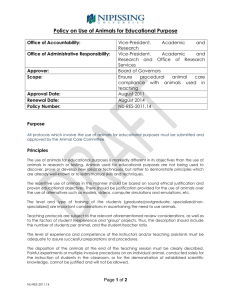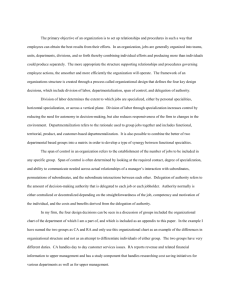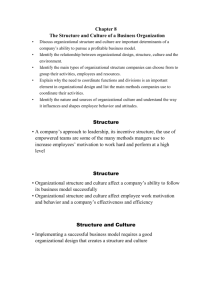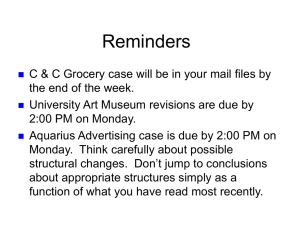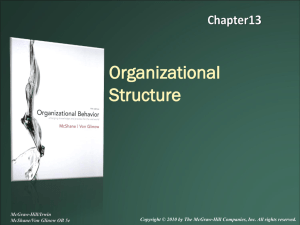Organizational Structure and Design Types of Structures: I. The
advertisement
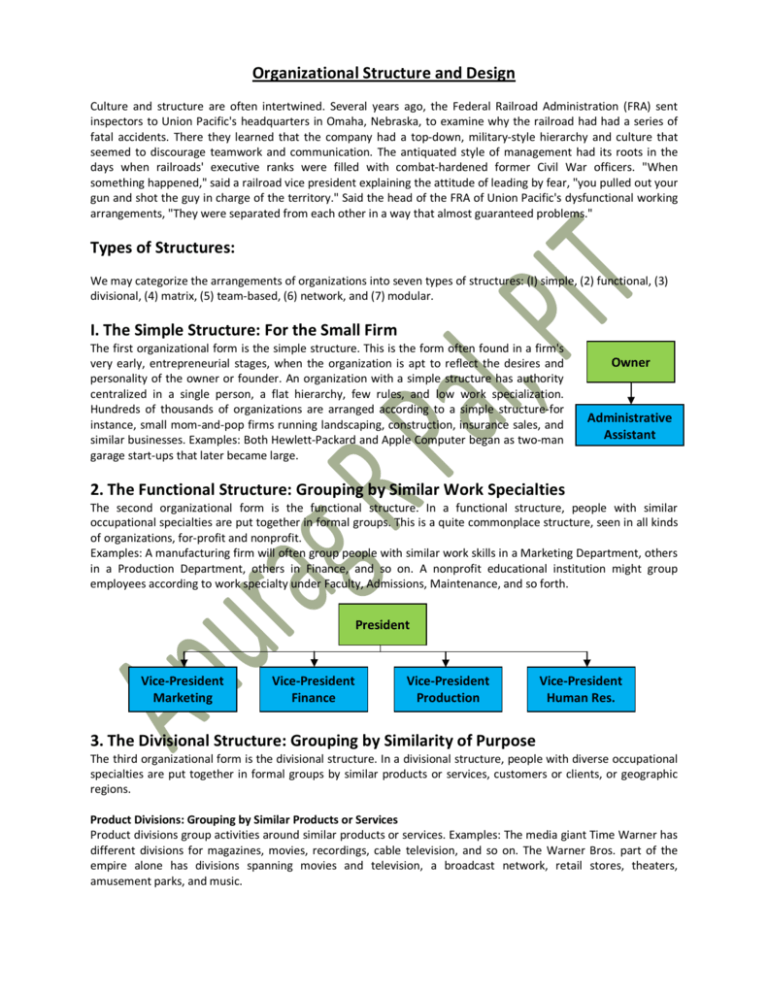
Organizational Structure and Design Culture and structure are often intertwined. Several years ago, the Federal Railroad Administration (FRA) sent inspectors to Union Pacific's headquarters in Omaha, Nebraska, to examine why the railroad had had a series of fatal accidents. There they learned that the company had a top-down, military-style hierarchy and culture that seemed to discourage teamwork and communication. The antiquated style of management had its roots in the days when railroads' executive ranks were filled with combat-hardened former Civil War officers. "When something happened," said a railroad vice president explaining the attitude of leading by fear, "you pulled out your gun and shot the guy in charge of the territory." Said the head of the FRA of Union Pacific's dysfunctional working arrangements, "They were separated from each other in a way that almost guaranteed problems." Types of Structures: We may categorize the arrangements of organizations into seven types of structures: (I) simple, (2) functional, (3) divisional, (4) matrix, (5) team-based, (6) network, and (7) modular. I. The Simple Structure: For the Small Firm The first organizational form is the simple structure. This is the form often found in a firm's very early, entrepreneurial stages, when the organization is apt to reflect the desires and personality of the owner or founder. An organization with a simple structure has authority centralized in a single person, a flat hierarchy, few rules, and low work specialization. Hundreds of thousands of organizations are arranged according to a simple structure-for instance, small mom-and-pop firms running landscaping, construction, insurance sales, and similar businesses. Examples: Both Hewlett-Packard and Apple Computer began as two-man garage start-ups that later became large. Owner Administrative Assistant 2. The Functional Structure: Grouping by Similar Work Specialties The second organizational form is the functional structure. In a functional structure, people with similar occupational specialties are put together in formal groups. This is a quite commonplace structure, seen in all kinds of organizations, for-profit and nonprofit. Examples: A manufacturing firm will often group people with similar work skills in a Marketing Department, others in a Production Department, others in Finance, and so on. A nonprofit educational institution might group employees according to work specialty under Faculty, Admissions, Maintenance, and so forth. President Vice-President Marketing Vice-President Finance Vice-President Production Vice-President Human Res. 3. The Divisional Structure: Grouping by Similarity of Purpose The third organizational form is the divisional structure. In a divisional structure, people with diverse occupational specialties are put together in formal groups by similar products or services, customers or clients, or geographic regions. Product Divisions: Grouping by Similar Products or Services Product divisions group activities around similar products or services. Examples: The media giant Time Warner has different divisions for magazines, movies, recordings, cable television, and so on. The Warner Bros. part of the empire alone has divisions spanning movies and television, a broadcast network, retail stores, theaters, amusement parks, and music. President MotionPictures Div. Books & Magazine Div. Music Div. Internet Products Div. Customer Divisions: Grouping by Common Customers or Clients Customer divisions tend to group activities around common customers or clients. Examples: Ford Motor Co. has separate divisions for passenger-car dealers, for large trucking customers, and for farm products customers. A savings and loan might be structured with divisions for making consumer loans, mortgage loans, business loans, and agricultural loans. President Consumer Loans Mortgage Loans Business Loans Agricultural Loans Geographic Divisions: Grouping by Regional Location Geographic divisions group activities around defined regional locations. Example: This arrangement is frequently used by government agencies. The Federal Reserve Bank, for instance, has 12 separate districts around the United States. The Internal Revenue Service also has several districts. President Northern Region Eastern Region Western Region Southern Region 4. The Matrix Structure: A Grid of Functional & Divisional for Two Chains of Command The fourth organizational form is the matrix structure. In a matrix structure, an organization combines functional and divisional chains of command in a grid so that there are two commands structures-vertical and horizontal. The functional structure usually doesn't change-it is the organization's normal departments or divisions, such as Finance, Marketing, Production, and Research & Development. The divisional structure may vary-as by product, brand, customer, or geographic region. A hypothetical example, using Ford Motor Co.: The functional structure might be the departments of Engineering, Finance, Production, and Marketing, each headed by a vice president. Thus, the reporting arrangement is vertical. The divisional structure might be by product (the new models of Taurus, Mustang, Explorer, and Expedition, for example), each headed by a project manager. This reporting arrangement is horizontal. Thus, a marketing person, say, would report to both the Vice President of Marketing and to the Project Manager for the Ford Mustang. Indeed, Ford Motor Co. used the matrix approach to create the Taurus and a newer version of the Mustang. President Functional Structure Vice-President Marketing Project Structure Vice-President Finance Vice-President Production Vice-President Human Res. Project Manager, Taurus Project Manager, Mustang Project Manager, Explorer Project Manager, Expedition 5. The Team-Based Structure: Eliminating Functional Barriers to Solve Problems The fifth organizational form is the team-based structure. In a team-based structure, teams or workgroups, either temporary or permanent, are used to improve horizontal relations and solve problems throughout the organization. 56 When managers from different functional divisions are brought together in teams-known as cross functional teams-to solve particular problems, the barriers between the divisions break down. The focus on narrow divisional interests yields to a common interest in solving the problems that brought them together. Yet team members still have their full-time functional work responsibilities and still formally report to their own managers above them in the functional-division hierarchy. President Functional Structure Vice-President Marketing Project Teams Vice-President Finance Product Team Manager, Manufacturing Light trucks Vice-President Production Product Team Manager, Manufacturing Sedans Vice-President Human Res. Product Team Manager, Manufacturing Sports Car Project Team Members 6. The Network Structure: Connecting a Central Core to Outside Firms by Computer Connections In the sixth organizational form, network structure, the organization has a central core that is linked to outside independent firms by computer connections, which are used to operate as if all were a single organization Corporations using this structure are sometimes called virtual corporations or virtual organizations. Another term used is the hollow corporation or hollow organization, in which the company retains important core processes critical to its performance (such as design or marketing) and outsources most other processes (such as human resources, warehousing, or distribution), thereby seeming to "hollow out" the organization. With a network structure, an organization can become a boundary-less organization, as we described in Chapter 2, operating with extensive, even worldwide operations, yet its basic core can remain small, thus keeping payrolls and overhead down. The glue that holds everything together is information technology, along with strategic alliances and contractual arrangements with supplier companies. Design Studio Sweden Engineering Company - Japan Core of Personal Computing Company – USA Components Assembly - Asia Distribution Company - Canada Accounting & Finance - USA 7. The Modular Structure: Outsourcing Pieces of a Product to Outside Firms The seventh organizational form differs from the sixth in that it is oriented around outsourcing certain pieces of a product rather than outsourcing certain processes (such as human resources or warehousing) of an organization. In a modular structure, a firm assembles product chunks, or modules, provided by outside contractors. One article compares this form of organization to "a collection of Lego bricks that can snap together.” We defined Organizing as arranging and structuring work to accomplish organizational goals. It’s an important process during which managers design an organization’s structure. Organizational structure is the formal arrangement of jobs within an organization. This structure, which can be shown visually in an Organizational chart, also serves many purposes. When managers create or change the structure, they’re engaged in Organizational design, a process that involves decisions about six key elements: work specialization, departmentalization, chain of command, span of control, centralization and decentralization, and formalization. Work Specialization At the Wilson Sporting Goods factory in Ada, Ohio, 150 workers (with an average tenure exceeding 20 years) make every football used in the National Football League and most of those used in college and high school football games. To meet daily output goals, the workers specialize in job tasks such as molding, stitching and sewing, lacing, and so forth. This is an example of work specialization, which is dividing work activities into separate job tasks. Individual employees “specialize” in doing part of an activity rather than the entire activity in order to increase work output. It’s also known as division of labor, a concept we introduced in the management history module. Work specialization makes efficient use of the diversity of skills that workers have. In most organizations, some tasks require highly developed skills; others can be performed by employees with lower skill levels. If all workers were engaged in all the steps of, say, a manufacturing process, all would need the skills necessary to perform both the most demanding and the least demanding jobs. Thus, except when performing the most highly skilled or highly sophisticated tasks, employees would be working below their skill levels. In addition, skilled workers are paid more than unskilled workers, and, because wages tend to reflect the highest level of skill, all workers would be paid at highly skilled rates to do easy tasks—an inefficient use of resources. This concept explains why you rarely find a cardiac surgeon closing up a patient after surgery. Instead, doctors doing their residencies in open-heart surgery and learning the skill usually stitch and staple the patient after the surgeon has finished the surgery. Departmentalization After deciding what job tasks will be done by whom, common work activities need to be grouped back together so work gets done in a coordinated and integrated way. How jobs are grouped together is called departmentalization. Five common forms of departmentalization are used, although an organization may develop its own unique classification. (For instance, a hotel might have departments such as front desk operations, sales and catering, housekeeping and laundry, and maintenance.) The diagrams below, illustrates each type of departmentalization as well as the advantages and disadvantages of each. Functional Departmentalization: Groups Jobs according to function. Plant Manager Manager Engineering Manager Purchasing Manager Accounting Manager Manufacturing + Efficiencies from putting together similar specialties and people with common skills, knowledge and orientation + Coordination within functional area + In-depth Specialization - Poor communication amongst functional areas - Limited view amongst Organizational goals Geographical Departmentalization: Groups Jobs according to Geographic Region. President for Sales Sales Director West Region Sales Director East Region Sales Director North Region Sales Director South Region + More effective and efficient handling of specific regional Issues that arise. + Serve needs of unique geographic markets better. - Duplication of functions - Can feel isolated from other organizational areas Product Departmentalization: Groups Jobs according to Product Line. Bombardier Ltd. Mass Transit Sector Mass Transit Division Recreational Products Division Recreational & Utility Vehicle Sector Bombardier – Rotax (Vienna) Logistic Equipment Division Rail Products Sector Rail & Diesel Products Division Industrial Equipment Division + Allows Specialization in particular product and services + Managers can become expert in their industry + Closer to customers - Duplication of functions - Limited view of organizational goals Chain of Command Suppose you were at work and had a problem with some issue that came up. What would you do? Who would you go to help you resolve that issue? People need to know who their boss is. That’s what the chain of command is all about. The chain of command is the line of authority extending from upper organizational levels to lower levels, which clarifies who reports to whom. Managers need to consider it when organizing work because it helps employees with questions such as “Who do I report to?” or “Who do I go to if I have a problem?” To understand the chain of command, you have to understand three other important concepts: authority, responsibility, and unity of command. Let’s look first at authority. Authority was a major concept discussed by the early management writers; they viewed it as the glue that held an organization together. Authority refers to the rights inherent in a managerial position to tell people what to do and to expect them to do it. Managers in the chain of command had authority to do their job of coordinating and overseeing the work of others. Authority could be delegated downward to lower-level managers, giving them certain rights while also prescribing certain limits within which to operate. These writers emphasized that authority was related to one’s position within an organization and had nothing to do with the personal characteristics of an individual manager. They assumed that the rights and power inherent in one’s formal organizational position were the sole source of influence and that if an order was given, it would be obeyed. Responsibility is when managers use their authority to assign work to employees; those employees take on an obligation to perform those assigned duties. This obligation or expectation to perform is known as responsibility. And employees should be held accountable for their performance! Assigning work authority without responsibility and accountability can create opportunities for abuse. Likewise, no one should be held responsible or accountable for work tasks over which he or she has no authority to complete those tasks. Unity of command is the unity of command principle (one of Fayol’s 14 management principles) states that a person should report to only one manager. Without unity of command, conflicting demands from multiple bosses may create problems as it did for Damian Birkel, a merchandising manager in the Fuller Brands division of CPAC, Inc. He found himself reporting to two bosses—one in charge of the department-store business and the other in charge of discount chains. Birkel tried to minimize the conflict by making a combined to-do list that he would update and change as work tasks changed. Span of Control How many employees can a manager efficiently and effectively manage? That’s what span of control is all about. The traditional view was that managers could not—and should not— directly supervise more than five or six subordinates. Determining the span of control is important because to a large degree, it determines the number of levels and managers in an organization—an important consideration in how efficient an organization will be. All other things being equal, the wider or larger the span, the more efficient an organization is. Here’s why. Assume two organizations, both of which have approximately 4,100 employees. As diagram below shows, if one organization has a span of four and the other a span of eight, the organization with the wider span will have two fewer levels and approximately 800 fewer managers. At an average manager’s salary of Rs 42,000 a year, the organization with the wider span would save over Rs 33 million a year! Obviously, wider spans are more efficient in terms of cost. However, at some point, wider spans may reduce effectiveness if employee performance worsens because managers no longer have the time to lead effectively. Centralization and Decentralization One of the questions that need to be answered when organizing is “At what organizational level are decisions made?” Centralization is the degree to which decision making takes place at upper levels of the organization. If top managers make key decisions with little input from below, then the organization is more centralized. On the other hand, the more that lower-level employees provide input or actually make decisions, the more decentralization there is. Keep in mind that centralization-decentralization is not an either-or concept. The decision is relative, not absolute—that is, an organization is never completely centralized or decentralized. Early management writers proposed that the degree of centralization in an organization depended on the situation. Their goal was the optimum and efficient use of employees. Traditional organizations were structured in a pyramid, with power and authority concentrated near the top of the organization. Given this structure, historically centralized decisions were the most prominent, but organizations today have become more complex and responsive to dynamic changes in their environments. As such, many managers believe that decisions need to be made by those individuals closest to the problems, regardless of their organizational level. In fact, the trend over the past several decades—at least in U.S. and Canadian organizations— has been a movement toward more decentralization in organizations. The table lists some of the factors that affect an organization’s use of centralization or decentralization. More Centralization More Decentralization Environment is stable. Lower-level managers are not as capable or experienced at making decisions as upper-level managers. Lower-level managers do not want a say in decisions. Decisions are relatively minor. Organization is facing a crisis or the risk of company failure. Environment is complex, uncertain. Lower-level managers are capable and experienced at making decisions. Lower-level managers want voice indecisions. Decisions are significant. Corporate culture is open to allowing managers a say in what happens. Company is geographically dispersed. Effective implementation of company strategies depends on managers having involvement and flexibility to make decisions. Company is large. Effective implementation of company strategies depends on managers retaining say over what happens. Formalization Formalization refers to how standardized an organization’s jobs are and the extent to which employee behavior is guided by rules and procedures. In highly formalized organizations, there are explicit job descriptions, numerous organizational rules, and clearly defined procedures covering work processes. Employees have little discretion over what’s done, when it’s done, and how it’s done. However, where formalization is low, employees have more discretion in how they do their work.
